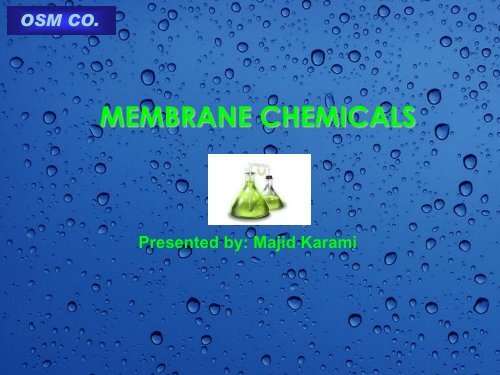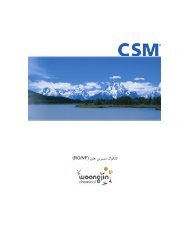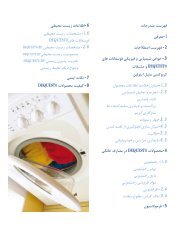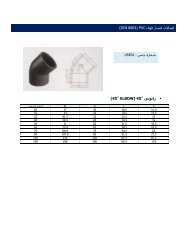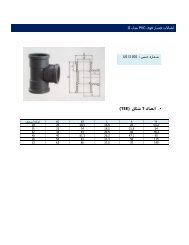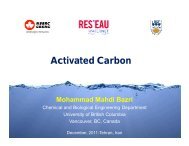MEMBRANE CHEMICALS
MEMBRANE CHEMICALS
MEMBRANE CHEMICALS
Create successful ePaper yourself
Turn your PDF publications into a flip-book with our unique Google optimized e-Paper software.
OSM CO.<br />
<strong>MEMBRANE</strong> <strong>CHEMICALS</strong><br />
Presented by: Majid Karami
OSM CO.<br />
Introduction<br />
★ Water shortage is becoming a worldwide problem<br />
★ One of the main solutions to this problem is :<br />
Desalination of seawater or brackish water<br />
★ Desalination of seawater accounts for a worldwide<br />
water production of 24.5 million m3/day and Iran’s share is<br />
about 505,000 m3/day (2009)<br />
★ Increasing the cost of transferring water and decreasing<br />
the desalination cost, has caused this technology to be<br />
more popular<br />
1
OSM CO.<br />
2
OSM CO.<br />
3
OSM CO.<br />
Introduction<br />
Desalination technology like any other technology has<br />
some issues and problems such as:<br />
★ Fouling<br />
★ Scaling<br />
★ Corrosion<br />
Which causes:<br />
★ A decrease in operational efficiency<br />
★ Negative effects on the environment<br />
★ Higher cost of water production in some areas<br />
4
OSM CO.<br />
Fouling & Scaling<br />
Fouling includes the accumulation of all kinds of layers on<br />
the membrane and feed spacer surface, including scaling,<br />
such as:<br />
★ Inorganic colloids: iron flocs, silica, clay, silt<br />
★ Organic colloids: oil, organic polymers, microorganisms<br />
Scaling will refer to the precipitation and desorption within<br />
the system of sparingly soluble salts such as:<br />
★ Calcium carbonate, barium sulfate, calcium sulfate,<br />
strontium sulfate, and calcium fluoride<br />
5
OSM CO.<br />
Pretreatment Options<br />
6
OSM CO.<br />
Cleaning Chemicals<br />
7
OSM CO.<br />
Scale Control Methods<br />
(1) Acid Addition:<br />
★ Effective in preventing the precipitation of CaCO3<br />
★ Ineffective in preventing other types of scale such as<br />
CaSO4<br />
★ Corrosivity of the acid<br />
(2) Softening:<br />
★ The main disadvantage of softening is cost ($)<br />
(3) Antiscalant Addition<br />
8
OSM CO.<br />
Antiscalant Addition<br />
9
OSM CO.<br />
Antiscalant Addition<br />
10
OSM CO.<br />
Antiscalant Addition<br />
11
OSM CO.<br />
Antiscalant Addition<br />
Dosage rates depends to:<br />
★ Water Analysis<br />
★ Flow rate<br />
★ Recovery<br />
★ Water source<br />
★ pH<br />
★ Temperature<br />
★ Membrane type & RO configuration<br />
★ Typical dosage rates are 1-6 mg/lit<br />
Recovery:<br />
★ As the recovery rate increases the concentration of<br />
dissolved salts in the reject water stream increases and<br />
leading to salt precipitation and scale formation<br />
12
OSM CO.<br />
Antiscalant Addition<br />
Dosage calculation:<br />
★ CoRoLa-T: software for selection of the most<br />
appropriate antiscalant for a specific system<br />
13
OSM CO.<br />
Antiscalant Addition<br />
14
OSM CO.<br />
Case Study<br />
A chemical manufacturing company in Iran:<br />
★ 7,000 m3/day two pass brackish water RO plant<br />
★ With brine recovery RO (BRRO)<br />
★ First pass with two identical skids (A & B)<br />
★ Each skid is two stages in 20:10 array<br />
★ Each pressure vessel having 6 membrane elements<br />
★ Both skids (A & B) have a design permeate flow of 143<br />
m3/hr at 63.5% recovery<br />
★ Total first pass production of 286 m3/hr<br />
★ Pretreatment for the first pass: aluminium salt<br />
coagulant, hydrochloric acid injection, chlorination, multimedia<br />
filtration, phosphonate based antiscalant injection,<br />
SMBS injection, cartridge filteration<br />
★ Second pass is designed to operate at 85% recovery<br />
15
OSM CO.<br />
Case Study<br />
Schematic of plant layout:<br />
16
OSM CO.<br />
Case Study<br />
Description:<br />
★ Raw water derives from underground wells<br />
★ Chemical water analysis (as ions): calcium of 785 mg/l,<br />
sulphate at 2149 mg/l, bicarbonate of 141 mg/l, with pH 7.5<br />
and TDS 4745 mg/l<br />
★ Scaling prediction: calcium carbonate, calcium sulphate<br />
and barium sulphate salts all exceeded their solubility<br />
limits<br />
★ Standard anttiscalant could inhibit calcium carbonate<br />
and barium sulphate but not calcium sulphate at these<br />
high values<br />
17
OSM CO.<br />
Case Study<br />
Problem:<br />
★ The first pass trains A & B of the plant historically<br />
suffered from calcium sulphate deposition<br />
★ Operators decided to reduce recovery rates to 48%<br />
against a design specification of 63.5%<br />
★ Even at lower recovery rates the membranes fouled<br />
after 4 - 5 weeks of operation with feed pressure<br />
increasing from 10 to 12.5 bar<br />
★ Cleaning was carried out when ∆P reached 6.5 bar by<br />
circulating a solution of Ethylene Diamine Tetra Acetic acid<br />
(EDTA) and Sodium TripolyPhosphate (STPP) at high pH<br />
18
OSM CO.<br />
Case Study<br />
Recommendations:<br />
★ In November 2007 the new calcium sulphate specific<br />
antiscalant was used and acid dosing was stopped<br />
★ At 4.7 mg/l dosed to the feed water this approch has<br />
successfully prevented scale formation<br />
★ The recovery rates were increased to 61%<br />
★ The plant requiring only one membrane clean in 18<br />
months instead of one every month as previously<br />
★ The second pass permeate polisher is operating without<br />
the need for antiscalant due to the good quality permeate<br />
from the first pass<br />
19
OSM CO.<br />
Case Study<br />
Initial design with 63.5% recovery:<br />
20
OSM CO.<br />
Case Study<br />
Results and cost saving for Water:<br />
21
OSM CO.<br />
Case Study<br />
Results and cost saving for Energy:<br />
★ Initial design:<br />
22
OSM CO.<br />
Case Study<br />
Results and cost saving for Energy:<br />
23
OSM CO.<br />
Case Study<br />
Conclusions:<br />
24
OSM CO.<br />
Case Study<br />
Conclusions:<br />
This Case Study demonstrates that the selection of the<br />
correct chemical programme and using species specific<br />
antiscalant can result in:<br />
★ Optimizing the recovery rate so as to minimize pumping<br />
costs<br />
★ Maintaining membrane cleanliness and reducing<br />
cleaning frequency<br />
★ Extending the lifespan of the membranes thereby<br />
reducing replacement costs<br />
★ Removing the dependency and the cost of dosing large<br />
quantities of non specific commodity chemicals which<br />
frequently has a positive environmental impact<br />
25


